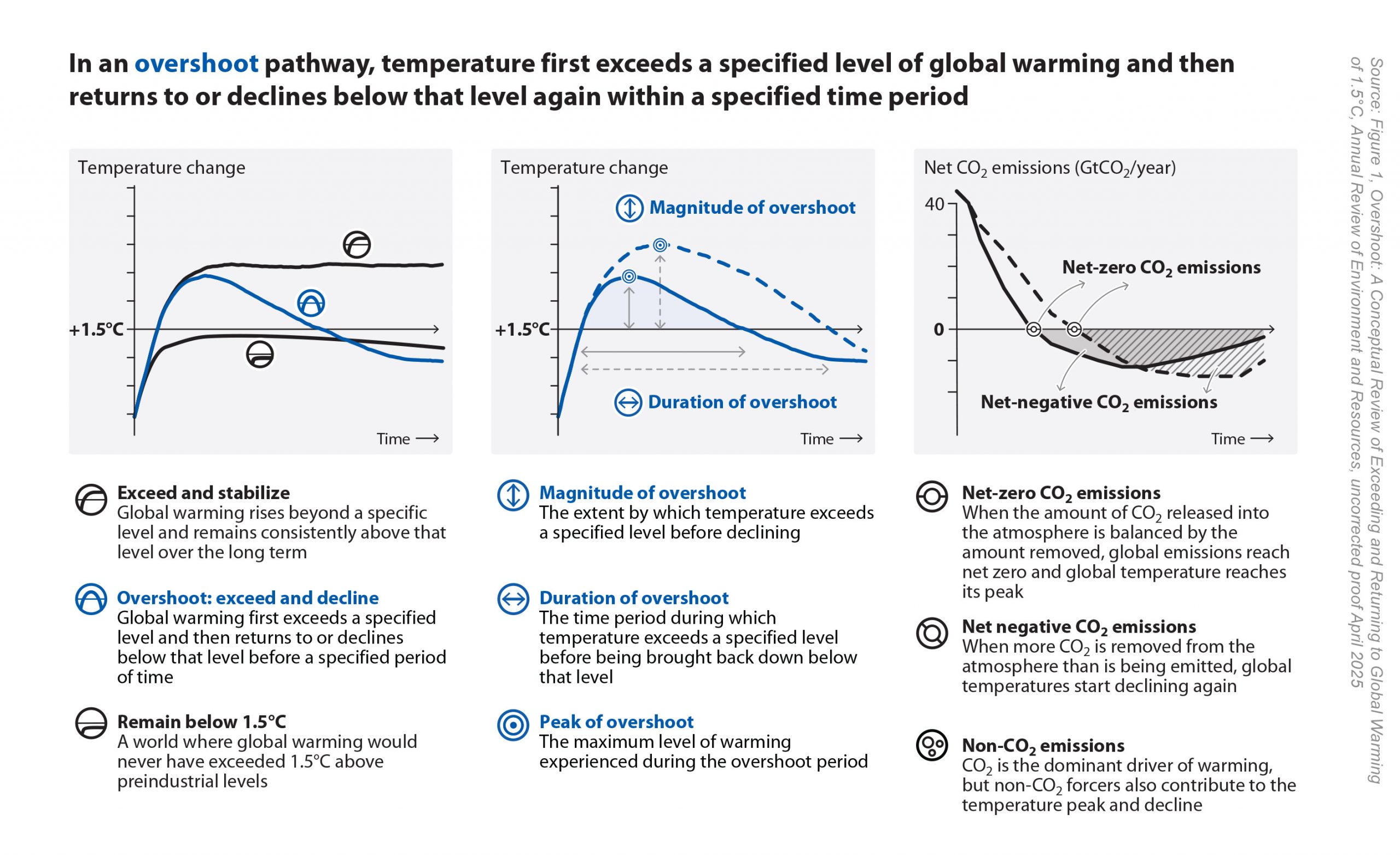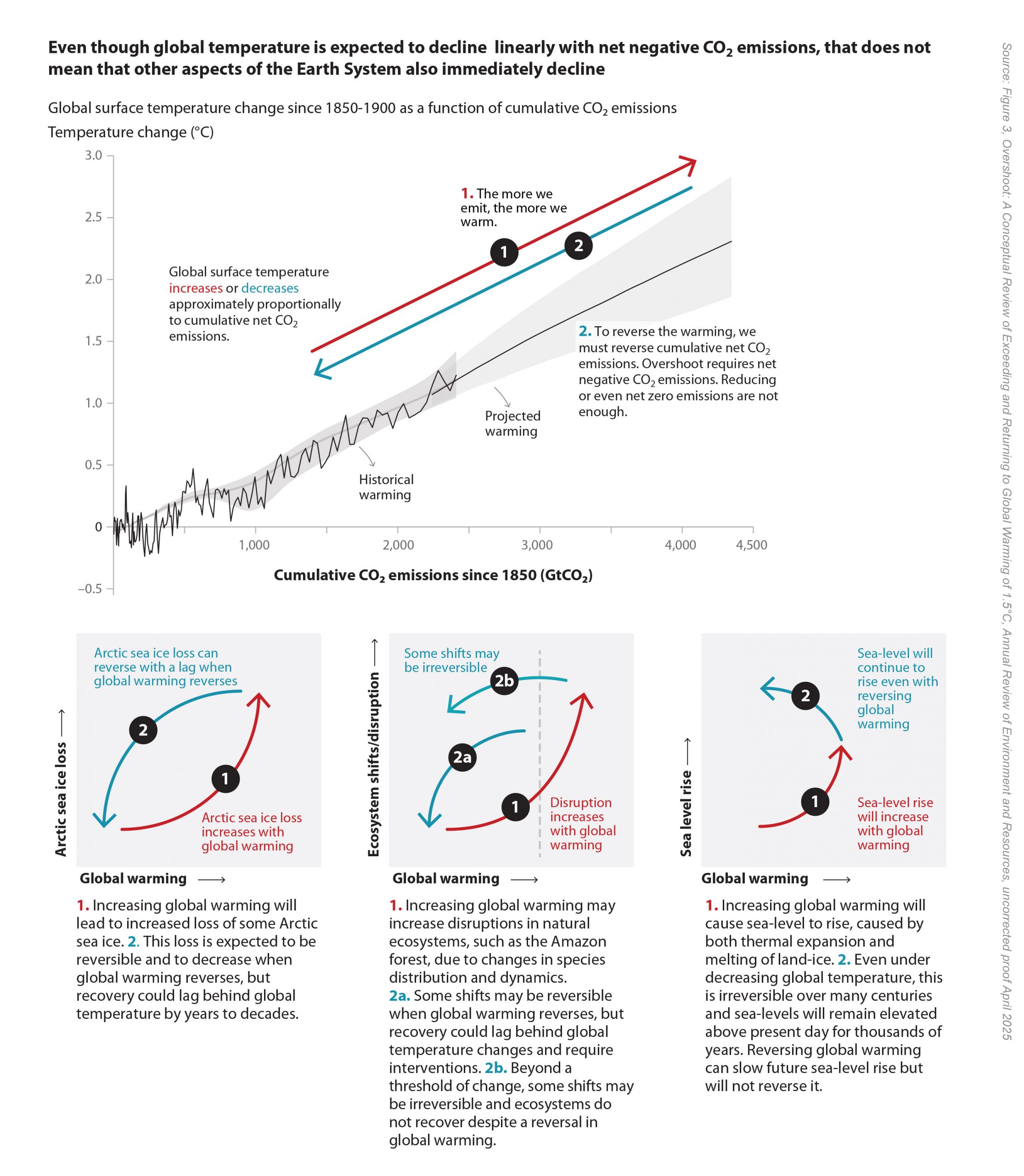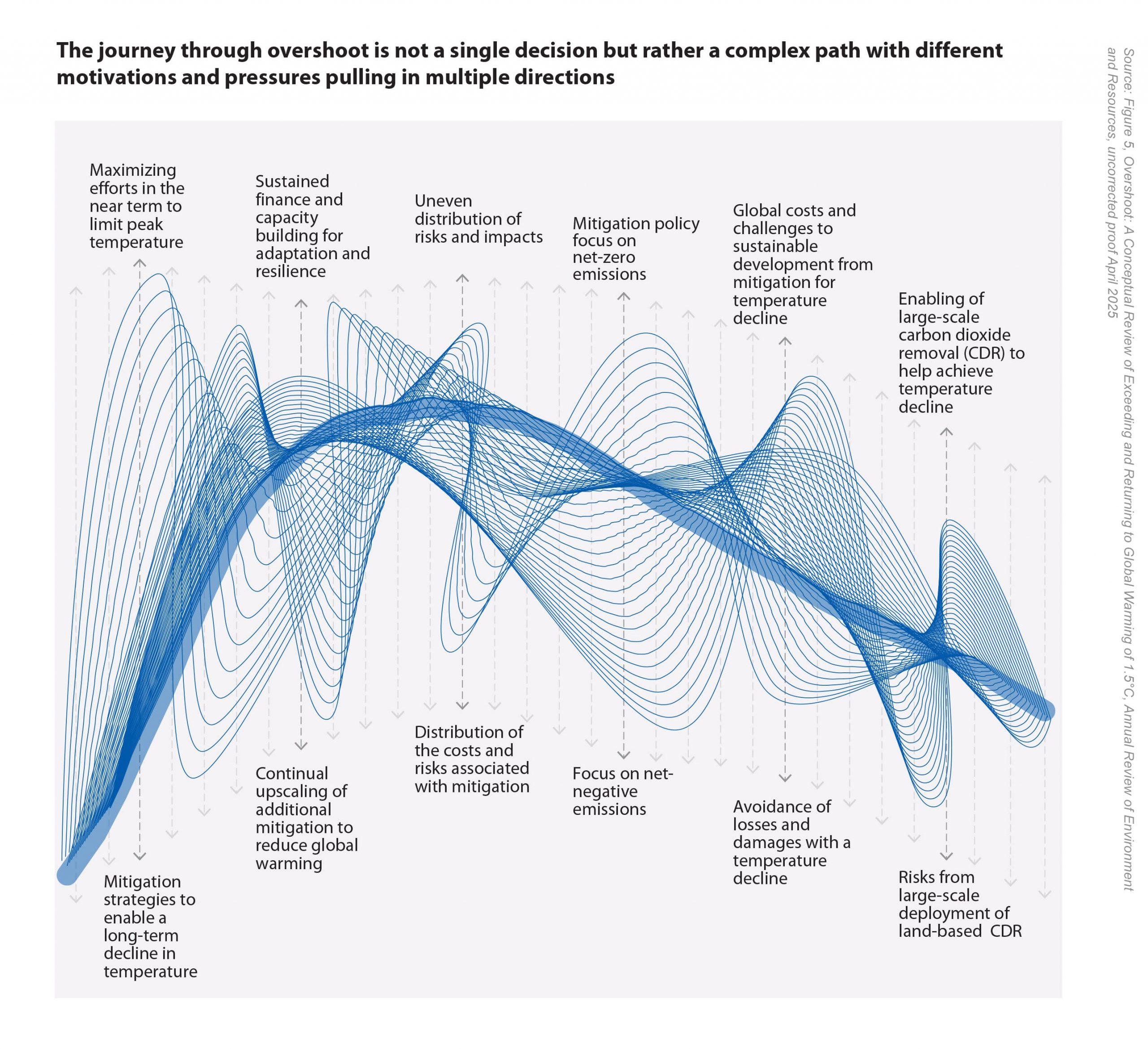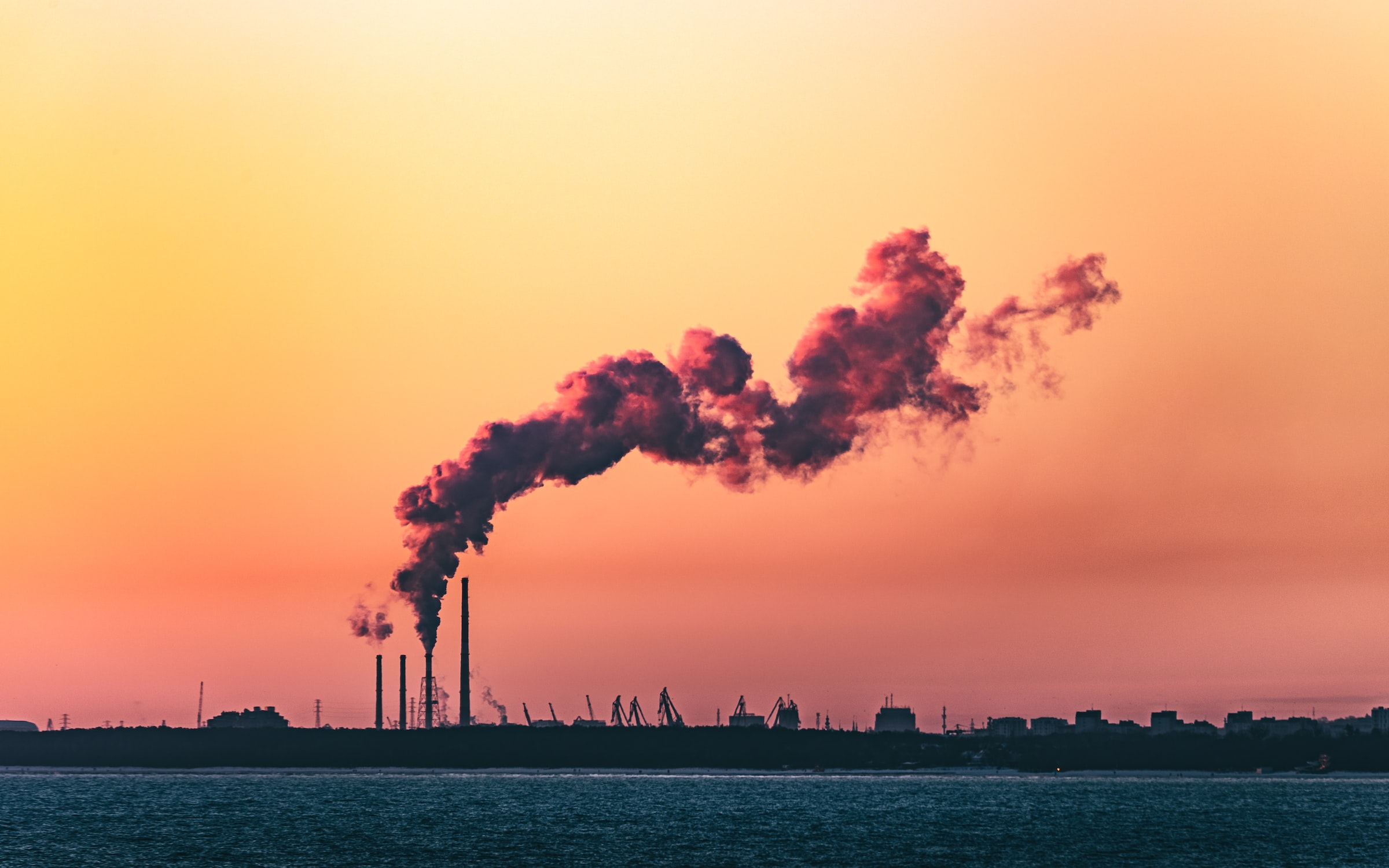Exceeding the 1.5°C goal set out in the Paris Agreement is no longer just a distant possibility. The Intergovernmental Panel on Climate Change (IPCC) estimates that there is at least a 50% chance of temporarily crossing this threshold in the near future, even under low emissions scenarios. This has placed renewed emphasis not only on how we intend to confront the immediate consequences for the environment and society, but also the long-term strategies that would be required to bring global warming back down. In a nutshell: overshoot.
Progress in science is needed to develop the tools and know-how to understand and address the complexities of temperature overshoot. The first comprehensive review explores the implications of such “overshoot” pathways. Authored by an international team of scientists and design experts involved in assessments by the IPCC, the new paper titled “Overshoot: a conceptual review of exceeding and returning to global warming of 1.5°C”, considers climate-related damages and risks, adaptation and vulnerability, global emission requirements, and issues arising for global and national climate policy, setting out evidence and knowledge gaps that illustrate the choices and challenges that decision-makers are now facing.
“The 2024 State of Global Climate report by the WMO shows how global annual temperatures are reaching levels of over 1.5°C increases and that emissions of GHGs continue to rise,” says Anna Pirani, CMCC researcher, director of the Predicting socio-economic outcomes program, alternate IPCC Focal Point for Italy, and co-author of the paper. “This not only leads to the question of when we will reach global warming of 1.5°C, generally assessed over two decade periods, but also by how much.”
To answer these questions CMCC has led the development of an overshoot digital information platform that expands on the insights gained from the paper. The platform offers a plain language narrative to navigate this complex issue – one that will shape climate discussions in the years to come, bridging science, policy, environment, society, and economics.
“We know that the impacts of such high levels of warming will be even more severe than what we are experiencing today, which makes the concept of overshoot central to the global discourse on climate change,” says Pirani.
Exploring and explaining different warming futures, mitigation options to reduce temperatures, Earth system responses to climate risks, and the feasibility of adaptation and mitigation strategies is central to overshoot and requires a multifaceted approach to the investigation of key drivers of climate-related risks and how they might evolve under different overshoot trajectories.
Warming pathways and overshoot dynamics
Surpassing 1.5°C carries profound risks for ecosystems, economies, and societies. Fragile ecosystems such as coral reefs, tropical rainforests, and polar ice sheets are particularly vulnerable to even temporary periods of heightened warming as they face the possibility of irreversible damage, including coral bleaching, biodiversity loss, and ice sheet collapse – all of which could trigger cascading effects on global systems.

There are three distinct global warming trajectories, as illustrated in the figure above: one where temperatures remain below 1.5°C, another where they exceed this threshold before declining, and a third where warming stabilizes above 1.5°C permanently. This highlights critical metrics of temperature overshoot: the magnitude of exceedance, the duration of elevated temperatures, and the peak warming level.
For instance, in an overshoot scenario, temperatures may exceed 1.7°C before returning below 1.5°C through mitigation efforts like carbon dioxide removal (CDR). The figure above underscores the importance of reaching net-zero emissions to halt temperature increases and achieving net-negative emissions to reverse warming trends.
“Exceeding a level of global warming of 1.5°C means that we will have surpassed the lower bound of the long term global temperature goal of the Paris Agreement,” says Pirani. “This doesn’t mean we have failed to meet that goal. The Paris Agreement can still be met by limiting global warming to below 2°C. It would allow for a trajectory of overshoot, exceeding 1.5°C and then ‘pursuing efforts to limit the temperature increase to 1.5°C’. For this reason the relationship between global policy and climate science will be ever more important.”
How will climate risk change in an overshoot world?
In an overshoot world, heightened hazards like extreme weather events and increased exposure due to population growth amplify risks compared to a stable 1.5°C world. In the figure below climate risks are compared across three different scenarios: a world that never exceeds 1.5°C, one that surpasses it and declines back in an overshoot, and one where warming stabilizes above this threshold. Each “propeller blade” represents a driver of climate risk – hazard, exposure, vulnerability, and responses – with blade height illustrating the contribution of each factor to overall risk.

Understanding and addressing these risks requires a multidisciplinary approach to climate science that is able to encompass the many facets of the overshoot concept. From exploring socio-economic pathways that achieve overshoot to understanding the Earth system’s response to it and how to mitigate their impact on society and nature.
CMCC’s C-BLUES project tackles an aspect of the risks presented by overshoot by studying carbon ecosystems and their ability to act as a buffer against hazards like sea-level rise. An effort which requires improving land carbon cycle modeling and assessing how ecosystems respond to climate change and land use changes. This is the mission of CMCC’s CONCERTO project which is developing a novel framework for understanding, monitoring and modeling the terrestrial carbon cycle to improve the quantification of ecosystem dynamics and enhance Earth system model climate projections.
Investigating the impacts on the carbon cycle of extreme events such as droughts, heatwaves and fires, which are projected to increase as temperatures continue to rise, is crucial in the context of a temperature overshoot future.
How does the Earth system respond to overshoot?
Exceeding temperature thresholds also increases the likelihood of crossing tipping points, which are critical markers beyond which large-scale changes become self-reinforcing and irreversible. For example, the thawing of permafrost could release vast amounts of methane into the atmosphere, further accelerating warming. Similarly, the destabilization of ice sheets could lead to significant sea level rise with devastating consequences for coastal communities worldwide.

The figure above focuses on the possible asymmetry in Earth system responses between rising and declining temperatures, showing that while global surface temperatures may decline with net-negative emissions, other Earth system components recover more slowly – or not at all.
For instance, Arctic sea ice loss is partially reversible but lags behind temperature reductions by decades, while sea-level rise remains irreversible over centuries due to thermal expansion and ice sheet melting.
Similarly, disruptions in ecosystems like the Amazon rainforest may require human intervention for recovery or could cross thresholds beyond which they become irreversible. CMCC’s RESCUE project examined these lagged recovery processes, whilst quantifying how delayed mitigation increases the likelihood of irreversible impacts through an investigation into Earth system responses to climate neutrality and net negative emissions.
How can we achieve an overshoot pathway?
There is growing evidence that it may be possible to reverse warming trends through enhanced mitigation efforts. Strategies to achieve this include achieving net-zero emissions as quickly as possible, targeting short-lived climate pollutants like methane for rapid reductions, and increasing the deployment of carbon dioxide removal (CDR) technologies.

CDR technologies play a crucial role in these scenarios by removing excess CO₂ from the atmosphere. However, scaling up these technologies requires significant investments in research, development, infrastructure, and governance. Achieving net-zero emissions already requires unprecedented levels of international cooperation and commitment to cutting residual emissions across all sectors.
CMCC’s UPTAKE project evaluates the scalability of CDR technologies, while exploring policy frameworks for phasing out fossil fuels equitably without exacerbating inequality, whereas OceanICU studies marine ecosystems’ capacity to absorb CO₂ amidst human activities like fishing and resource extraction.
How do we navigate an overshoot pathway?
The feasibility of bringing temperatures back below 1.5°C depends on how quickly and effectively mitigation measures are implemented. The challenge of navigating an overshoot pathway is not merely a scientific or technical issue. It is a multidirectional process shaped by competing pressures – including uncertainty in the Earth system response, economic constraints, technological innovation, and social equity concerns – all potentially pulling in different directions, as illustrated in the figure below.

For example, overshoot is deeply intertwined with questions of equity and justice as vulnerable communities are often the most affected. Ensuring that these communities are prioritized in adaptation efforts is essential in the achievement of fair and inclusive climate action.
The figure above aligns with CMCC’s interdisciplinary approach to addressing overshoot through projects like NEWPATHWAYS, which co-designs decarbonization strategies with stakeholders to balance trade-offs between mitigation urgency and adaptive capacity. By integrating Earth system science with socio-economic modeling, CMCC equips policymakers with tools to navigate this complex path, while minimizing irreversible impacts and centering equity in climate action.
A path forward
Navigating a future where global temperatures exceed 1.5°C requires an integrative approach: minimizing peak warming through accelerated mitigation efforts, preparing for its consequences through adaptation strategies, and fostering international collaboration on emissions reductions, scaling up carbon removal technologies responsibly, and prioritizing equity in all aspects of climate policy.
The choices made today will determine whether exceeding 1.5°C remains a temporary setback or a prolonged crisis. By integrating science, policy, and societal perspectives into decision-making processes, stakeholders can work toward a future where economic prosperity aligns with climate stability – but the window of opportunity is constricting and every fraction of a degree in global warming matters.
“Progress is needed in understanding how to achieve a global temperature decline and how these trajectories impact society and nature from global to regional and local scales, including what governance and policy dimensions can underpin such a trajectory,” says Pirani. “In the path ahead, the modelling multiverse will need to integrate the interplay of the climate system, impacts on society and nature, and socio-economic development more interactively, as well as including a broader interface with social sciences to understand desirability, on top of the feasibility of such pathways.”
More information:
- read the paper:
Overshoot: A Conceptual Review of Exceeding and Returning to Global Warming of 1.5°C, Andy Reisinger, Jan S. Fuglestvedt, Anna Pirani, Oliver Geden, Chris D. Jones, Shobha Maharaj, Elvira Poloczanska, Angela Morelli, Tom Gabriel Johansen, Carolina Adler, Richard A. Betts, Sonia I. Seneviratne. Annu. Rev. Environ. Resour. 2025. 50:1.1–1.33. https://doi.org/10.1146/annurev-environ-111523-102029 - visit the platform: CMCC Overshoot
- Overshoot: What does it mean to exceed and return to global warming of 1.5°C?
Image credits: InfoDesign Lab






